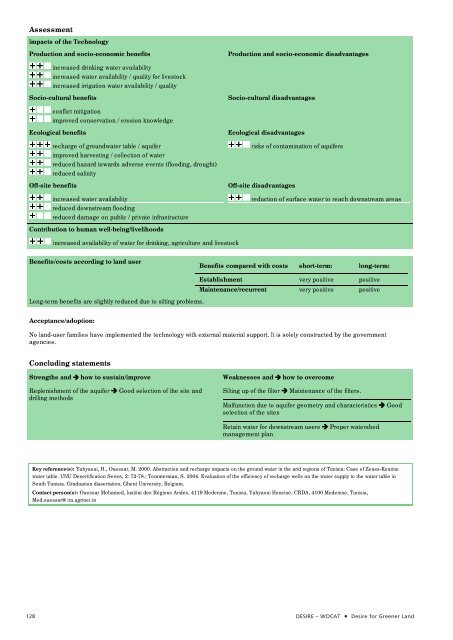Desire for Greener Land
Desire for Greener Land
Desire for Greener Land
You also want an ePaper? Increase the reach of your titles
YUMPU automatically turns print PDFs into web optimized ePapers that Google loves.
Assessment<br />
Impacts of the Technology<br />
Production and socio-economic benefits Production and socio-economic disadvantages<br />
increased drinking water availability<br />
increased water availability / quality <strong>for</strong> livestock<br />
increased irrigation water availability / quality<br />
Socio-cultural benefits Socio-cultural disadvantages<br />
conflict mitigation<br />
improved conservation / erosion knowledge<br />
Ecological benefits Ecological disadvantages<br />
recharge of groundwater table / aquifer<br />
improved harvesting / collection of water<br />
reduced hazard towards adverse events (flooding, drought)<br />
reduced salinity<br />
Off-site benefits Off-site disadvantages<br />
increased water availability<br />
reduced downstream flooding<br />
reduced damage on public / private infrastructure<br />
Contribution to human well-being/livelihoods<br />
increased availability of water <strong>for</strong> drinking, agriculture and livestock<br />
Benefits/costs according to land user<br />
Long-term benefits are slightly reduced due to silting problems.<br />
Acceptance/adoption:<br />
risks of contamination of aquifers<br />
reduction of surface water to reach downstream areas<br />
Benefits compared with costs short-term: long-term:<br />
Establishment very positive positive<br />
Maintenance/recurrent very positive positive<br />
No land-user families have implemented the technology with external material support. It is solely constructed by the government<br />
agencies.<br />
Concluding statements<br />
Strengths and how to sustain/improve Weaknesses and how to overcome<br />
Replenishment of the aquifer Good selection of the site and<br />
drilling methods<br />
Silting up of the filter Maintenance of the filters.<br />
Malfunction due to aquifer geometry and characteristics Good<br />
selection of the sites<br />
Retain water <strong>for</strong> downstream users Proper watershed<br />
management plan<br />
Key reference(s): Yahyaoui, H., Ouessar, M. 2000. Abstraction and recharge impacts on the ground water in the arid regions of Tunisia: Case of Zeuss-Koutine<br />
water table. UNU Desertification Series, 2: 72-78.; Temmerman, S. 2004. Evaluation of the efficiency of recharge wells on the water supply to the water table in<br />
South Tunisia. Graduation dissertation, Ghent University, Belgium.<br />
Contact person(s): Ouessar Mohamed, Institut des Régions Arides, 4119 Medenine, Tunisia, Yahyaoui Houcine, CRDA, 4100 Medenine, Tunisia,<br />
Med.ouessar@ira.agrinet.tn<br />
128 DESIRE – WOCAT <strong>Desire</strong> <strong>for</strong> <strong>Greener</strong> <strong>Land</strong>









